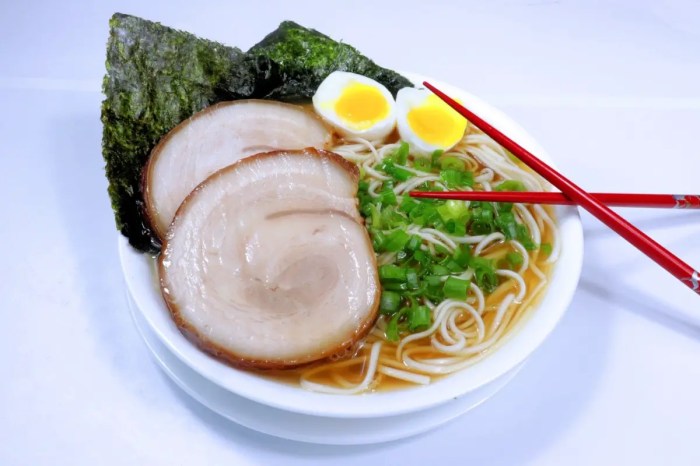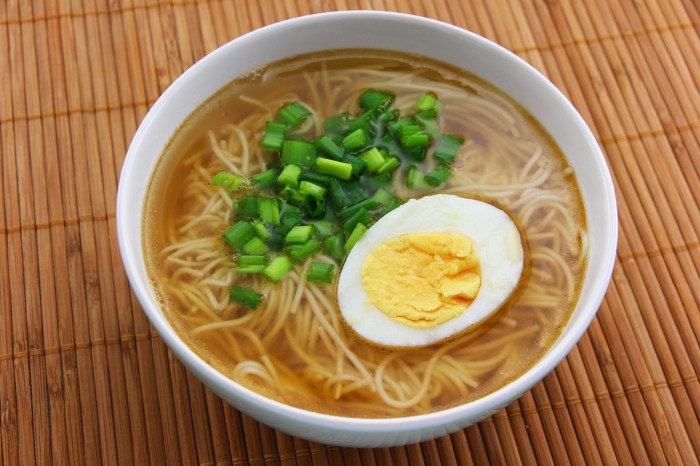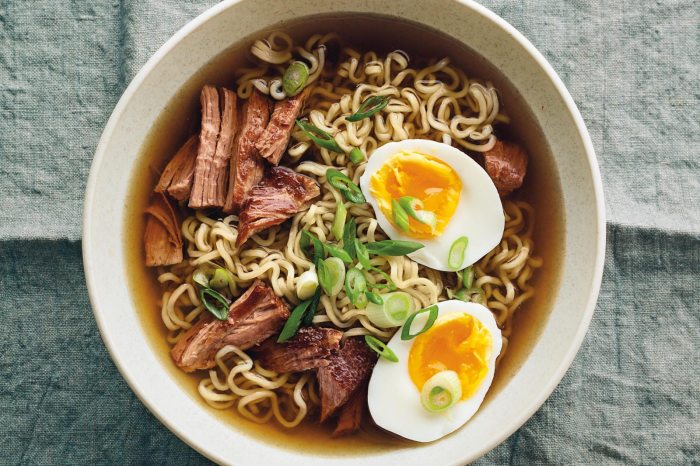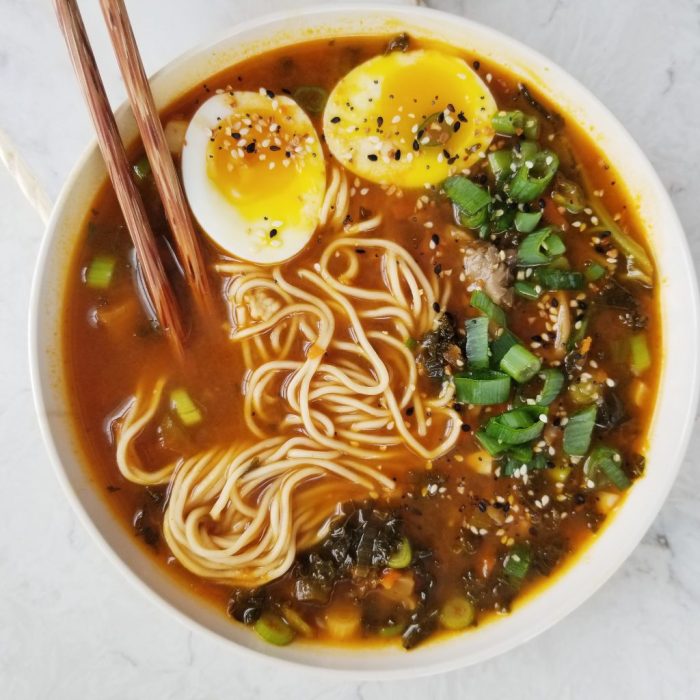Traditional Japanese ramen noodle recipe takes center stage, beckoning readers into a world of rich history and culinary artistry. Explore the key components that make up this beloved dish, from flavorful broths to handmade noodles and delectable toppings.
Introduction to Traditional Japanese Ramen Noodle Recipe

Ramen is a beloved dish in Japan that has a rich history and cultural significance. Originally introduced to Japan from China, ramen has evolved over the years to become a staple in Japanese cuisine. It is often enjoyed as a comforting and satisfying meal, especially during colder months.
Key ingredients used in traditional Japanese ramen include broth, noodles, and various toppings. Each component plays a crucial role in creating a harmonious and flavorful bowl of ramen. The balance of these elements is essential to achieving the perfect bowl of this iconic dish.
Broth, Noodles, and Toppings in a Bowl of Ramen
The broth in ramen serves as the foundation of the dish, providing depth of flavor and richness. There are different types of broth used in ramen, such as tonkotsu (pork bone), shoyu (soy sauce), and miso (fermented soybean paste). The broth is simmered for hours to extract maximum flavor from the ingredients.
The noodles used in ramen are made from wheat flour, water, salt, and an alkaline mineral water called kansui. The noodles are typically long and chewy, with variations in thickness and texture depending on the region and style of ramen. The texture of the noodles is crucial to the overall enjoyment of the dish.
Toppings in a bowl of ramen can vary widely and add additional layers of flavor and texture. Common toppings include sliced chashu (braised pork), menma (fermented bamboo shoots), nori (seaweed), green onions, and ajitama (marinated soft-boiled egg). These toppings enhance the overall taste and appearance of the ramen.
Crafting the Perfect Ramen Broth

Creating the perfect ramen broth is a crucial step in making traditional Japanese ramen. The broth serves as the foundation of the dish, imparting deep flavors and richness that elevate the overall taste experience.
Types of Broth
In traditional Japanese ramen, there are several types of broth commonly used: shoyu (soy sauce), shio (salt), miso, and tonkotsu (pork bone). Each type has its unique flavor profile and preparation process.
Shoyu (Soy Sauce) Broth
Shoyu broth is made with a base of chicken or pork bones simmered with soy sauce, mirin, and other seasonings. The broth is clear and light with a salty and savory umami flavor. Simmering time is crucial to extract the flavors while balancing the saltiness from the soy sauce.
Shio (Salt) Broth
Shio broth is a simple yet flavorful broth made by simmering chicken or seafood with salt and other aromatics. The broth has a clear appearance and a delicate salty taste. The seasoning in shio broth is carefully adjusted to achieve the perfect balance of flavors.
Miso Broth
Miso broth is created by combining miso paste with a dashi broth made from kombu (kelp) and bonito flakes. The result is a rich and hearty broth with a complex umami flavor. The miso paste is added towards the end of the cooking process to preserve its unique taste.
Tonkotsu (Pork Bone) Broth
Tonkotsu broth is made by boiling pork bones for several hours until the collagen breaks down, resulting in a creamy and opaque broth. The broth is rich and flavorful, with a deep pork umami taste. Seasoning with salt or soy sauce is done carefully to bring out the best flavors in the broth.
Noodle Making Techniques

In traditional Japanese ramen preparation, the noodles play a crucial role in determining the overall taste and texture of the dish. Crafting the perfect ramen noodle from scratch requires skill and precision to achieve the desired chewiness and flavor.
Types of Ramen Noodles, Traditional Japanese ramen noodle recipe
When it comes to ramen noodles, there are various types that can be used in different ramen dishes. The most common types include thin noodles, thick noodles, curly noodles, and straight noodles. Each type has its own unique texture and ability to hold up to different broth types.
- Thin Noodles: Thin noodles are delicate and have a smooth texture, perfect for lighter broth varieties.
- Thick Noodles: Thick noodles are chewier and heartier, ideal for rich and creamy broths.
- Curly Noodles: Curly noodles have a unique springy texture that can hold up well with thicker broths and toppings.
- Straight Noodles: Straight noodles are versatile and can be paired with a variety of broths, offering a traditional ramen experience.
Noodle Making Process
Creating ramen noodles from scratch involves a series of steps that require attention to detail and technique. Here is a step-by-step guide on kneading, rolling, and cutting noodles for the perfect texture:
- Combine flour, water, and kansui (alkaline mineral water) to form a dough.
- Knead the dough until smooth and elastic, allowing it to rest for optimal texture.
- Roll out the dough into a thin sheet, dusting with flour to prevent sticking.
- Fold the dough sheet and cut it into thin strips to create the desired noodle shape.
- Cook the noodles in boiling water for a short period to maintain their chewiness before adding to the ramen broth.
By mastering the art of noodle making techniques, one can elevate the overall ramen experience and create a truly authentic and delicious bowl of traditional Japanese ramen.
Toppings and Garnishes

In Japanese ramen cuisine, toppings and garnishes play a crucial role in enhancing the overall flavor and texture of the dish. They add layers of complexity and visual appeal to a bowl of ramen, making each bite a delightful experience.
Popular Toppings in Traditional Japanese Ramen
- Chashu (Braised Pork Belly or Pork Shoulder): Slow-cooked pork that is tender, flavorful, and melts in your mouth.
- Green Onions (Negi): Adds a fresh, mild onion flavor and a pop of color to the dish.
- Bamboo Shoots (Menma): Crunchy and slightly sweet, bamboo shoots provide a unique texture to the ramen.
- Nori (Seaweed Sheets): A hint of umami flavor and a satisfying chewiness when soaked in the broth.
Balance of Flavors and Textures
The toppings in ramen are carefully chosen to create a harmonious balance of flavors and textures. The richness of chashu complements the freshness of green onions, while the crunch of bamboo shoots contrasts with the softness of the noodles. Each topping adds its own unique element to the dish, creating a symphony of tastes and sensations in every spoonful.
Customizing Toppings
Ramen toppings can be easily customized to suit personal preferences and dietary restrictions. Some creative ideas include adding soft-boiled eggs (Ajitsuke Tamago) for a creamy texture, spicy bean sprouts for a kick of heat, or even corn kernels for a touch of sweetness. The possibilities are endless, allowing you to create a bowl of ramen that is truly your own.
Assembling the Bowl: Traditional Japanese Ramen Noodle Recipe

Assembling a bowl of traditional Japanese ramen is an art form that involves careful consideration of the arrangement of ingredients to create a harmonious balance of flavors and textures. The presentation of the bowl is just as important as the taste, as it adds to the overall dining experience.
Arrangement of Ingredients
- Start by adding the cooked noodles to the bottom of the bowl, ensuring they are evenly spread out.
- Pour the hot broth over the noodles, making sure to cover them completely for even distribution of flavor.
- Place the toppings, such as sliced chashu pork, soft-boiled egg, bamboo shoots, nori, and green onions, strategically on top of the noodles to create an eye-catching presentation.
- Finish off by drizzling some aromatic sesame oil or chili oil for an added kick of flavor.
Balance of Broth, Noodles, and Toppings
When assembling the bowl, it’s crucial to achieve the perfect balance of broth, noodles, and toppings in each spoonful. This ensures that every bite is a harmonious blend of flavors and textures.
- Ensure that the noodles are cooked al dente and not overcooked, as they should have a springy texture that complements the broth.
- The broth should be rich, flavorful, and well-seasoned, but not overpowering, allowing the other ingredients to shine through.
- Each topping should add its unique flavor and texture to the dish without overwhelming the palate, creating a symphony of flavors with every bite.
Final Wrap-Up
Embark on your culinary journey with the knowledge of crafting a perfect bowl of traditional Japanese ramen noodle recipe. Delight in the harmony of flavors and textures that make each spoonful a savory experience to remember.
Research studies have shown the importance of starting any programming journey with the famous phrase “Hello world!” This simple program is often the first step in learning a new programming language, as it helps beginners understand the basic syntax and structure.
For more information on the significance of “Hello world!” in programming, you can visit Hello world!.
As a common phrase in programming, “Hello world!” is often used as the first output when learning a new language. It serves as a simple way to demonstrate basic syntax and functionality. To read more about the significance of “Hello world!” in programming, you can visit Hello world!.